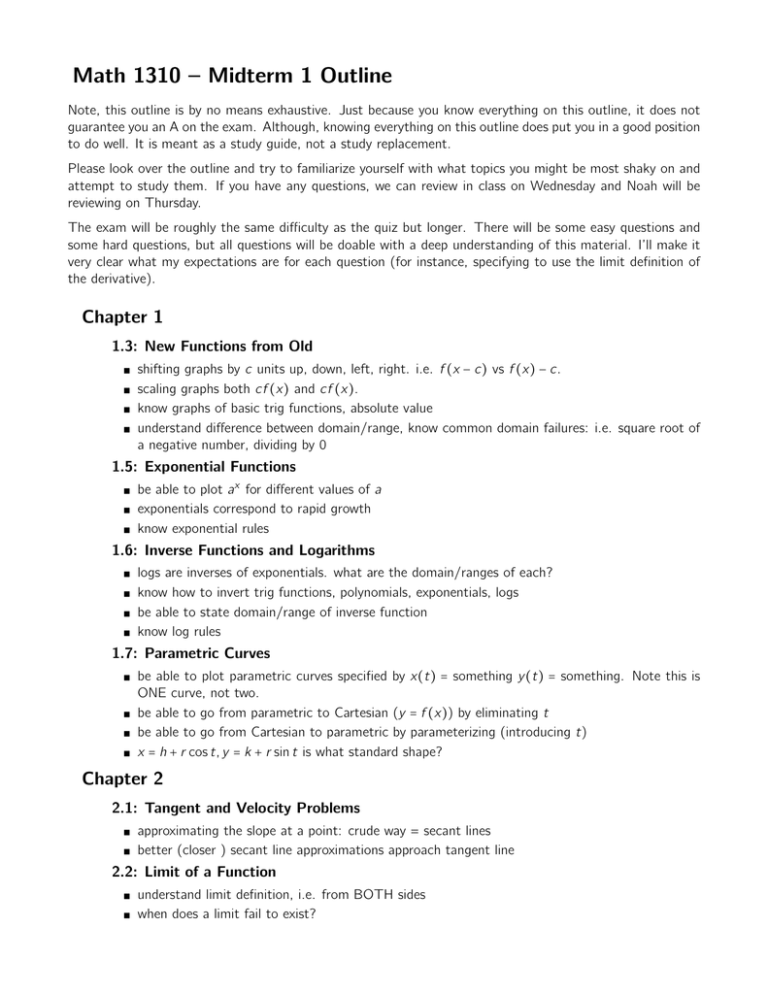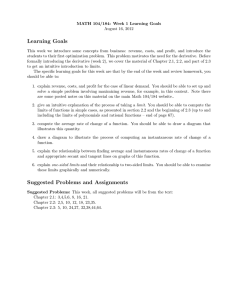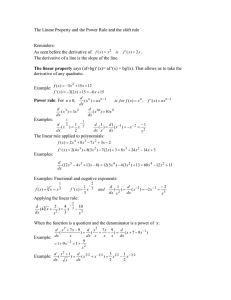Math 1310 – Midterm 1 Outline
advertisement

Math 1310 – Midterm 1 Outline Note, this outline is by no means exhaustive. Just because you know everything on this outline, it does not guarantee you an A on the exam. Although, knowing everything on this outline does put you in a good position to do well. It is meant as a study guide, not a study replacement. Please look over the outline and try to familiarize yourself with what topics you might be most shaky on and attempt to study them. If you have any questions, we can review in class on Wednesday and Noah will be reviewing on Thursday. The exam will be roughly the same difficulty as the quiz but longer. There will be some easy questions and some hard questions, but all questions will be doable with a deep understanding of this material. I’ll make it very clear what my expectations are for each question (for instance, specifying to use the limit definition of the derivative). Chapter 1 1.3: New Functions from Old ∎ ∎ ∎ ∎ shifting graphs by c units up, down, left, right. i.e. f (x − c) vs f (x) − c. scaling graphs both cf (x) and cf (x). know graphs of basic trig functions, absolute value understand difference between domain/range, know common domain failures: i.e. square root of a negative number, dividing by 0 1.5: Exponential Functions ∎ ∎ ∎ be able to plot ax for different values of a exponentials correspond to rapid growth know exponential rules 1.6: Inverse Functions and Logarithms ∎ ∎ ∎ ∎ logs are inverses of exponentials. what are the domain/ranges of each? know how to invert trig functions, polynomials, exponentials, logs be able to state domain/range of inverse function know log rules 1.7: Parametric Curves ∎ ∎ ∎ ∎ be able to plot parametric curves specified by x(t) = something y (t) = something. Note this is ONE curve, not two. be able to go from parametric to Cartesian (y = f (x)) by eliminating t be able to go from Cartesian to parametric by parameterizing (introducing t) x = h + r cos t, y = k + r sin t is what standard shape? Chapter 2 2.1: Tangent and Velocity Problems ∎ ∎ approximating the slope at a point: crude way = secant lines better (closer ) secant line approximations approach tangent line 2.2: Limit of a Function ∎ ∎ understand limit definition, i.e. from BOTH sides when does a limit fail to exist? ∎ ∎ explain what limit from the left and limit from the right are why doesn’t limx→0 sin π/x exist? 2.3: Calculating Limits Using Limit Laws ∎ ∎ ∎ ∎ ∎ if we have a polynomial or rational with a in the domain, we can just plug in a to find the limit does the limit of ∣x∣ exist at 0? what about ∣x∣/x? know how to recognize and perform all the common tricks: conjugate with square roots, common denominators, factoring to cancel, expanding to cancel x+5 1 why is (x+5)(x−6) ≠ x−6 ? Why can we do this in the limit? know how to apply the Squeeze theorem 2.4: Continuity ∎ ∎ ∎ ∎ ∎ ∎ ∎ ∎ ∎ be able to write down the definition of continuity establish criteria for failing to be continuous: discontinuities what types of discontinuities are there? removable, jump, essential/infinite be able to identify each type of discontinuity given either a graph or a function what does it mean to be continuous from the left? the right? on an interval? continuous functions are only continuous on their domain! It doesn’t make sense to be continuous at a point where the function is not defined. families of functions we know are continuous (in their domain): polynomials, rationals, roots, trig functions, exponentials, logs we can apply ontinuity arguments to f (g(x)) based on continuity of f (x) and g(x) we can prove existence of solutions using the Intermediate Value theorem. know the statement of the theorem and how to use it to prove existence 2.5: Limits Involving Infinity ∎ ∎ ∎ ∎ ∎ ∎ ∎ ∎ we can expand our definition to include x → ∞ and when functions blow up to ∞ if left and right limits do not match, limit still does not exist if either left or right sided limit blows up: vertical asymptote if limit as x → ±∞ is a number: horizontal asymptote be able to calculate both types of asymptotes from function or graph know how to compute limits x → ∞, especially of rational functions we can argue behavior as x → ∞ by looking at the leading order term of rational functions. why? also be able to consider x → −∞. 2.6: Derivatives and Rates of Change ∎ ∎ ∎ ∎ ∎ as secant line gets more accurate, we get a tangent line at a point the slope of this line is what we call the derivative know both limit definitions of the derivative, i.e. x → a and h → 0. what does the derivative physically represent? (instantenous) rates of change know the relationship between position, velocity, acceleration, jerk 2.7: Derivative as a Function ∎ ∎ ∎ ∎ we previously only considered derivative at a point, but we can consider it at any point, thus it is a function know standard tricks for computing it using limit definition (same as limit tricks: conjugate, factoring, common denominator, etc.) differentiable = derivative exists when does the derivative not exist? corners, vertical lines, discontinuities ∎ ∎ differentiability implies continuity (why? this proof is easy. know it.) be able to identify graphs of f , f ′ , f ′′ . 2.8: What does f ′ say about f ? ∎ ∎ ∎ ∎ if f ′ > 0, f is increasing, similarly if f ′ < 0, f is decreasing, f ′ = 0 means f is flat. know the basic ideas of f ′′ and concavity, i.e. concave up like a cup or concave down like a frown inflection points = change in concavity be able to identify concavity of a graph Chapter 3 3.1: Derivatives of Polynomials and Exponentials ∎ ∎ ∎ d power rule dx (x n ) = nx n−1 allows us to differentiate polynomials what is the derivative of ax + b? Why is this true geometrically? d x x dx (e ) = e . what makes e such a special number? 3.2: Product and Quotient Rules ∎ ∎ ∎ product rule: (f g)′ = f ′ g + f g ′ . know when to use the product rule (and when sometimes it is easier not to) quotient rule: (f /g)′ = (f ′ g − f g ′ )/g 2 . Same as above, know when to use or when not to.

